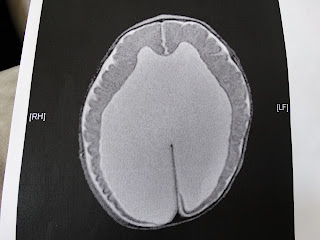Our sweet girl is now 6 months old, 20 pounds and almost 27 inches long! As cliché as it sounds,
time has gone by too fast. I enjoy watching her grow, but I wish I could pause
time for just a little bit.
We finally got our referral for vision therapy approved by
the neuro-ophthalmologist! The
structures of her eyes still look healthy and her nystagmus seems to have
resolved. Emily was diagnosed with
intermittent slight exotropia, which means her eyes occasionally drift outwards. However, I haven’t seen her eyes do that in a
long time so I’m not convinced. The
neuro-ophthalmologist said she saw her left eye do it once during the exam, so
we’ll agree to disagree. They aren’t
doing anything about it at this point anyway so it doesn’t matter – it just
adds to her long list of diagnoses. The main
takeaway from the appointment is the diagnosis of Cortical/Cerebral Visual
Impairment, or CVI. Just like the
seizure diagnosis (which ended up getting retracted), it made this mama’s heart
a little sad, which I tell myself is silly because I’m not surprised. I could have told you that she had it before
we even had the appointment. I’m trying
to prepare myself for a lifetime of diagnoses secondary to the hydrocephalus,
but is that something you can even prepare yourself for? 99% of the time, I
feel we live a “normal” life and I embrace everything that Emily does or doesn’t
do. But that 1% of the time, I feel
cheated, desperate to fix something I can’t fix, and knocked down. But as always, I pick myself back up and get
back to living this wonderful life with my amazing girl. I’m starting to think I will always have to
deal with that 1%.
Whew, sorry for the rambling! Anyway, CVI basically means the eyes work
just fine; it’s the part of the brain that processes vision that is
impaired. It’s a complicated diagnosis
that affects each person differently and I’m in mommy-research mode trying to
find anything I can do to help Emily reach her full potential. I’m eager to start vision therapy because
they will be able to better pinpoint where her vision is lacking and what we
can do to help. Thank goodness for
neuro-plasticity – some children with CVI can improve their vision with a lot
of work. Honestly I’m a little
overwhelmed with this information because it’s hard to know what/how/where she
sees things, and what to do to help her.
The impairment can range from not seeing objects clearly, to not seeing
certain objects at all, changes in seeing colors, details, lines, shadows,
depth perception, loss of peripheral vision, blind spots, etc. I observe Emily more than I’d care to admit
and I’ve noticed things that are “off.”
She clearly sees faces but I can hold a toy in front of her and it’s as
if she doesn’t see it at all. Sometimes,
if it makes noise or moves, she will suddenly “see” it. But she won’t track it from side to side, a
lot of the time. If the toy touches her
chest or hands, she will grab it quickly, as if she didn’t see it before and is
using touch to find it. I don’t
understand how she can make such good eye contact with us, but then doesn’t
seem to see toys right in front of her, at the same distance our faces are from
her. It’s not that she doesn’t care
about toys – she clearly shows excitement when playing with toys and brings
them to her mouth. Also, at this age,
children typically look at an object, pick it up, mouth it, look at it again –
thus learning about that object and making a schema, or “folder” for it in
their brain. Every object they explore adds
and enhances that schema in their brain.
Emily only rarely looks at toys she is playing with. In fact, as time goes on, I feel she is
relying more on touch and sound and her vision isn’t playing much of a part in
her playtime. She also gets easily
overwhelmed with many different objects at once, or visual clutter as it’s
called in many CVI resources I’ve read.
New experiences overwhelm her, too, and she doesn’t appear to look at
much when we’re out and about. Since CVI
is caused by brain damage, it can range in severity from day to day, and
different times of the day. For example,
when the brain is tired or focusing on different skills, it can cause the
visual area to respond even slower. I
have noticed that with Emily – sometimes she is visually attentive to something
specific but then acts as if she doesn’t see the same thing at another
time. When experiencing something new,
she deviates her eyes downward and to the left and I think that’s her brain’s
way of coping – like it’s too much to handle.
She’s doing it more frequently, and I’m not sure what to think of
it. Moving on from CVI stuff…
To no one’s surprise, Emily loves eating pureed food! So far, she has had rice cereal, apples,
pears, prunes, chicken and avocado. She
seems to like all of them, avocado being her favorite so far. I decided to make her food at home and I’m
enjoying it! Easy peasy and cheaper than store-bought food.
She also decided to start sleeping through the night all of
a sudden, about 2 weeks ago! With that,
we moved her into her crib in her room. She
is doing better with it than mommy is! I
just miss her so much and almost can’t wait for her to wake up so I can sneak
her in our bed again. Pathetic, I know.
Stay tuned for some cute Halloween pictures!



























